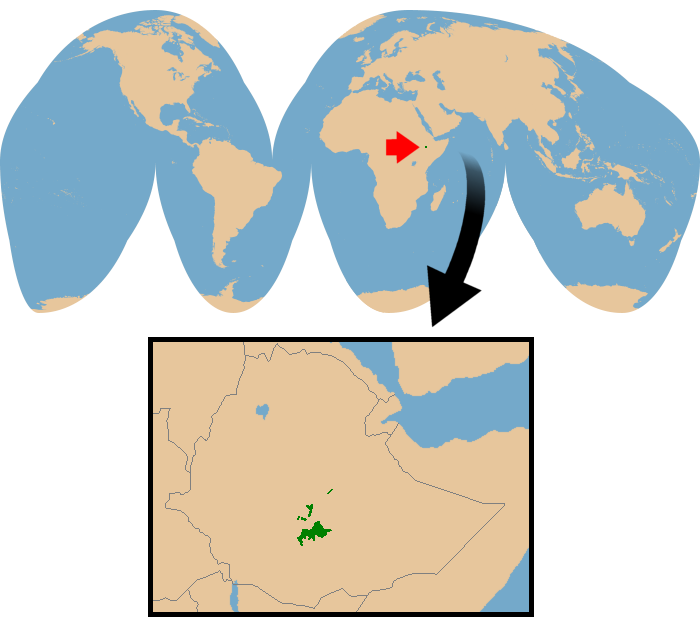Kingdom: |
Animalia Chordata Mammalia Artiodactyla Ruminantia Bovidae Bovinae Tragelaphini Tragelaphus |
Common name:
Scientific name:
Other names:
|
Mountain nyala
Tragelaphus buxtoni
|
Physical Characteristics
-
Head and body length: 190-200 cm (females), 240-260 cm (males)
- Shoulder height: 90-110 cm (females), 120-135 cm (males)
- Tail length: 20-25 cm
- Adult weight: 150-200 kg (females), 180-300 kg (males)
- Shoulder height: 90-110 cm (females), 120-135 cm (males)
Mountain nyala are generally a grey-brown color, but, since the coat is short and glossy in summer and shaggy in winter, the color can appear quite variable. Males tend to be darker, and young animals often have golden undertones to their coat. There is usually a pattern of white spots and a few stripes on the flanks. On the face, there is a distinctive white chevron between the eyes and two white spots on each cheek. There are two patches of white on the underside of the neck, a "bib" at the throat and a narrow crescent on the chest. Males are larger than females, and are easily distinguished by the presence of horns (the females are hornless). The horns are lyrate, usually with one and a half or two twists, and may grow up to 118 cm long.
-
Similar species
- Greater kudu (Tragelaphus strepsiceros) males have a shaggy fringe on the throat and much longer horns with a distinctive corkscrew spiral. Both sexes are lighter in color than the mountain nyala, with well-defined vertical stripes on the body.
Reproduction and Development
-
Gestation period: 8-9 months.
- Litter size: 1.
- Weaning: 3-4 months.
- Sexual maturity: Females at 2-3 years of age. Males may be mature at this time, but cannot win breeding rights until 5-8 years.
- Litter size: 1.
Mountain nyala may be born through the year, although there is usually a peak which coincides with climate (April to June in Bale, October to December in Arussi further north). The baby lies up in dense cover for a few weeks, being visited by its mother only for nursing. Young may remain with their mothers for two years.
Ecology and Behavior
-
Family group: Small groups of 2-13 animals, principally females and
young but often including a mature male. Old males are solitary.
- Diet: Leaves of herbs and shrubs, sometimes grasses, ferns, and lichens.
- Main Predators: Leopard, possibly lion and hyena.
- Diet: Leaves of herbs and shrubs, sometimes grasses, ferns, and lichens.
Habitat and Distribution

Conservation Status
-
IUCN Red List: Endangered (2008).
- CITES Listing: Not listed (2009).
- Threats: Habitat loss (agriculture and human development), hunting by humans for food and horns.
- CITES Listing: Not listed (2009).
The estimated total population is around 4,000 animals.






